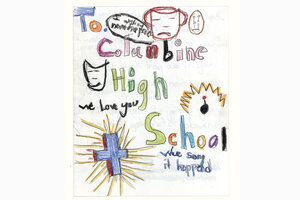Museums turn to ‘100 objects’ exhibits
Museums in Colorado, Virginia, and other locations have been inspired by a 2010 BBC series in which the British Museum presented world history in 100 objects.

A card sent to Columbine students is on display at the History Colorado Center.
Courtesy of History Colorado Center
One object in an exhibition of 100 drew particular attention at the History Colorado Center, Colorado’s state history museum.
Following the Feb. 14 shooting at a Florida high school in which 17 people died, History Colorado exhibit developer Julie Peterson said visitors were struck by the poignancy of a 1999 crayon-on-paper condolence card that a third-grader wrote after the shooting at Columbine High School.
“Objects really do have resonance and relevance today, even if they are historical,” Ms. Peterson says.
Curators around the world have multiplied that power by 100 in exhibitions since a 2010 BBC series in which the British Museum presented world history in 100 objects. The series was narrated by museum director Neil MacGregor.
“The British Museum project was a genius idea...,” said Rosemary Harden, manager at England’s Fashion Museum, Bath, where “A History of Fashion in 100 Objects” is on display until 2019. “We thought this was a great framework to use to present some of our real treasures, objects, and stories.”
In “Mr. Jefferson’s Telescope: A History of the University of Virginia in One Hundred Objects,” author Brendan Wolfe wrote about a cross burned outside the Charlottesville, Va., home of Sarah Patton Boyle. The civil rights activist, who was married to a University of Virginia professor, left the charred cross and her papers to the university.
The cross revealed a racism some in Charlottesville might not want to acknowledge but which was on display during a deadly Aug. 12, 2017, white nationalist march in the city. When a university exhibit based on Wolfe’s book opened weeks after the march, Molly Schwartzburg, curator of the Albert and Shirley Small Special Collections Library, left the cross’s display case empty. She had not wanted to add to the community’s pain.
“A single object can open up a huge set of stories,” Ms. Schwartzburg said, adding that an absence can be as important as an object.

